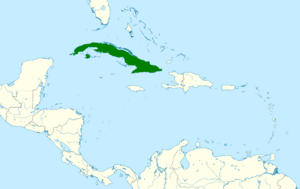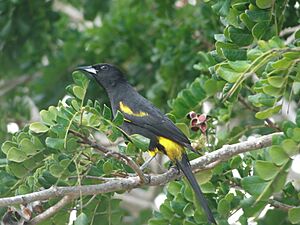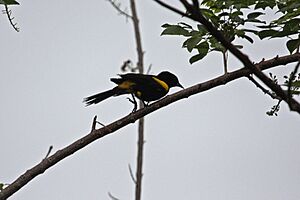Cuban oriole facts for kids
Quick facts for kids Cuban oriole |
|
|---|---|
 |
|
| Juvenile | |
| Conservation status | |
| Scientific classification | |
 |
The Cuban oriole is a type of songbird found only in Cuba. Its scientific name is Icterus melanopsis.
Adult Cuban orioles are about 20 cm (8 inches) long. They are mostly black with bright yellow spots on their shoulders, under their wings, and near their tail. Both male and female adult birds look the same. Young birds start out olive green. As they grow, they get a black face and throat.
For a long time, the Cuban oriole was thought to be the same species as three other orioles. These were the Bahama oriole, Hispaniolan oriole, and Puerto Rican oriole. They were all called the Greater Antillean oriole. But in 2010, scientists decided they were all different species.
These birds live in many places in Cuba. They can be found in dry forests, wet forests, and even plantations.

Contents
About the Cuban Oriole
For many years, scientists debated if the Cuban oriole was its own species. In 1890, a scientist named Allen said they were separate. But in 1936, James Bond (a bird expert, not the spy!) grouped them together. He called them the Greater Antillean oriole.
His idea was popular for a long time. However, in 2010, new evidence changed things. Scientists looked at the birds' DNA, feathers, and songs. They found big differences between the four types of orioles. So, they were split into four separate species again. This new DNA evidence also showed that the Cuban oriole and Bahama oriole are very closely related.
Where Do Cuban Orioles Live?
Their Home Island
Cuban orioles live only on the island of Cuba. They also live on a nearby island called Isla de la Juventud. This means they are endemic to these islands.
Different Habitats
These birds can live in many different places in Cuba. They are found in plantations, thick forests, and even near human homes. You might often see them looking for food in coral trees. They eat insects and nectar from these trees. They also like to build their nests under the leaves of palm trees.
What Do They Look Like?
Adult Cuban orioles are mostly black. They have a blue-grey patch on their lower beak. They also have bright yellow patches on their shoulders, rump, and upper legs. They look a lot like the Bahama, Puerto Rican, and Hispaniolan orioles. This is why they were once thought to be the same species.
Even though they are related, Cuban orioles are the darkest of these four birds. The Bahama oriole, which is their closest relative, has the most yellow.
Growing Up
Like many other orioles, Cuban orioles change their feathers as they grow. This is called delayed plumage maturation. When they first leave the nest, young Cuban orioles are mostly olive green. As they get older, they grow black feathers around their throat and beak.
It's very hard to tell male and female Cuban orioles apart just by looking at them. This is called very little sexual dimorphism. You would likely need a DNA test to know their sex.
What Do They Eat?
The Cuban oriole eats many different things. They are omnivorous. This means they eat both plants and animals. Their diet includes insects, soft fruits, and nectar. They get nectar from plants like banana trees, citrus trees, and coral trees.
Most of their diet is insects. But they can also be "nectar robbers." When they want nectar, they sometimes make a hole under the flower. They drink the nectar through this hole. This means they get the nectar without helping the plant with pollination.
How Do They Reproduce?
Building Nests
Cuban orioles are nesting songbirds. Like some other tropical orioles, they might stay with the same mate for their whole lives. From February to July, they build hanging nests. These nests look like baskets. They make them from materials found on palm and banana tree leaves.
A female oriole usually lays three eggs. The eggs are greenish-white with grey or olive spots. Like most tropical orioles, a pair of Cuban orioles might keep the same territory all year. They will also protect their nest from animals that might try to harm it.
Their Songs
Cuban orioles are songbirds, so they can sing! Their long song lasts about three seconds and has 11 to 12 notes. Their short song is about two seconds long with 5 to 6 notes. Their call sounds like a sharp chip followed by a nasal wheenk.
Scientists have seen both male and female Bahama and Puerto Rican orioles sing. So, it's likely that both male and female Cuban orioles can sing too. But more study is needed to be sure.
Conservation Status
The IUCN Red List listed the Cuban oriole as "Least Concern" in 2012. This means they are not currently in danger of disappearing. However, the Cuban oriole faces a challenge from the Shiny cowbird. The Shiny cowbird is a brood parasite. This means it lays its eggs in the nests of other birds, like the Cuban oriole. The orioles then raise the cowbird chicks as their own.
Images for kids
-
Adult bird in Cayo Coco






